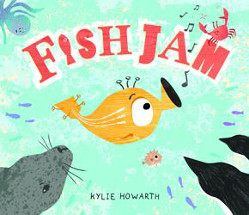Fish jam by Kylie Howarth

Five Mile Press, 2015. ISBN 9781499800982
(Age: 3-8 years) Toot the fish loves making noise. He swims through
the sea 'scooba-dooba-diddly-dooo'-ing and
'beep-bop-bubbly-booo'-ing, but none of the other sea creatures want
to play with him because they think he is too noisy. Toot is pretty
downhearted. He can't stop making his loud, musical noises but he
keeps being told to 'shhh' and 'shoo!' It isn't until Toot is
unexpectedly swallowed by a huge blue whale that he finds a place
where he fits right in - in the band living inside the whale's
stomach!
This fun picture book uses simple, large illustrations and texture
created through layered colours and printing. Bold writing gives
precedence to the sounds being made by Toot and the other sea
creatures, encouraging young children to make the sounds themselves.
Toot himself is a funny looking fish which highlights the musical
theme of the story. He is the colour of a brass instrument, has a
horn for a nose, clarinet buttons on his back and a guitar tail. The
illustrations focus on facial expressions and emotion as Toot
becomes sadder and sadder as he is shushed and shooed by the other
animals. We also see the anger of the great white sharks as they
shoo away Toot with their stern eyes, sharp teeth and oversized
'SHOO!' The second-to-last page folds out to show the inside of the
whale and the band of sea animals.
This book contains limited narration with only 6 sentences
throughout. Told largely through illustrations, and with the aid of
the dialogue and sounds made by the sea animals, this story is
useful for encouraging inferential comprehension and prediction.
Young children will also enjoy reading the story themselves using
the illustrations and their own imagination.
The last page explains, in a simple sentence, the concept of scat
singing, where nonsense syllables are used instead of words to sing
a song. It encourages the reader to use their own voice as an
instrument and make up their own sounds to make a song. In addition
to its usefulness in text comprehension it would be great to use
when teaching melody and in encouraging children to experiment with
making music. The style of the writing and the illustrations invite
children to become active participants, and is a perfect text for
discussion and involvement.
Nicole Nelson